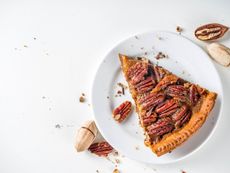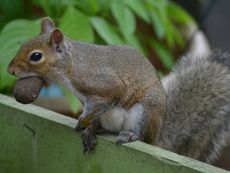Pecan Nematospora – Tips For Treating Pecan Kernel Discoloration

Pecan trees have long been a garden staple across much of the southern United States. While many growers plant these trees as a way to expand their gardens and begin harvesting various types of nuts at home, mature pecan trees are able to withstand even the harshest conditions. Though hardy, not all pecan trees are created equal, as many varieties demonstrate differing degrees of stressors. Maintaining healthy pecan trees is the key to years of successful nut harvests. One of the most common factors of poor nut production in pecan trees is the result of stressed trees. Pecan trees which become stressed are much more susceptible to many types of fungal disease, as well as increased insect pressure. These stressors not only impact the growth of the tree but may also cause the quantity and quality of the pecan harvest to suffer. Events such as cold temperatures, high humidity, and even drought are all responsible for the potential loss of pecan harvests. Pecan nematospora is another issue.
What is Nematospora of Pecans?
While many fungal infections may affect the growth of the tree, others such as pecan kernel discoloration will directly impact the quality of the pecan kernels. This fungal infection is caused by the fungal pathogen called nematospora. Most often, the fungus in pecan trees is caused by the damage done by stink bugs. The most obvious sign of this disease occurs at harvest time. Infected pecan kernels will show distinct blotches of darkening and, in some cases, completely brown pecan kernels. The darkened color most often varies greatly throughout the harvest.
Controlling Nematospora of Pecans
While pecan nemotaspora is difficult to recognize and diagnose throughout the growing season, there are some steps gardeners are able to take to help reduce the chances of infection. Above all, proper home orchard maintenance is key. This includes routine sanitation and removal dead or diseased plant materials. The removal of these materials will discourage the presence of stink bugs, as well as remove any previously infected plant matter. Adherence to a frequent irrigation program will also help to prevent plant stress and result in overall healthier pecan trees.
Gardening tips, videos, info and more delivered right to your inbox!
Sign up for the Gardening Know How newsletter today and receive a free download of our most popular eBook "How to Grow Delicious Tomatoes."

Tonya Barnett has been gardening for 13 years. Flowers are her passion. She has trasformed her backyard into a cut flower garden, which she regularly chronicles on her YouTube channel http://www.youtube.com/@tonyawiththeflowers.
-
 How To Keep Peonies From Falling Over: 5 Fixes For Floppy Flowers
How To Keep Peonies From Falling Over: 5 Fixes For Floppy FlowersPeonies are cottage garden favorites, but they can be prone to flopping. Support peonies with these practical ideas that can double as attractive features.
By Melanie Griffiths
-
 9 Bird-Friendly Flowering Plants: Flowers That Attract Birds Through The Seasons
9 Bird-Friendly Flowering Plants: Flowers That Attract Birds Through The SeasonsChoose the right flowering plants and your garden will become a favorite hangout for avian visitors. Try these nine flowers that attract birds to your yard
By Tonya Barnett
-
 From Harvest To Table: How To Make The Perfect Pecan Pie
From Harvest To Table: How To Make The Perfect Pecan PieFall is pecan harvest time, which means it’s also time for the perfect pecan pie recipe. Read on for more.
By Amy Grant
-
 Root Pecan Cuttings – Can You Grow Pecans From Cuttings
Root Pecan Cuttings – Can You Grow Pecans From CuttingsPecans are delicious, so much so that if you have a mature tree, your neighbors are likely envious. You may want to root pecan cuttings in order to grow a few trees for gifting. Will pecans grow from cuttings though? Click here for info on pecan cutting propagation.
By Teo Spengler
-
 How To Plant Pecans: Learn About Sowing Pecan Seeds
How To Plant Pecans: Learn About Sowing Pecan SeedsGrowing pecans from seed is not as simple as it sounds. Sowing pecan seeds is only one step in a complex process of growing a nut producing tree. Can you plant a pecan seed? Click here to find out and get tips on how to plant pecans and pecan seed germination.
By Teo Spengler
-
 Help, Pecans Are Gone: What’s Eating My Pecans Off The Tree
Help, Pecans Are Gone: What’s Eating My Pecans Off The TreeIt’s definitely unpleasant to walk outside to admire your pecan tree and find half your nuts are gone! You may begin to wonder what could be eating your pecans. Click this article for ideas on different pests that eat pecans so you can save more of the tasty nuts for yourself.
By Teo Spengler
-
 Using Pecans In The Kitchen: What To Do With Pecans
Using Pecans In The Kitchen: What To Do With PecansWith such a large quantity of nut production, one might wonder what to do with pecans. Cooking with pecans is the most common of uses, but there are other ways of using pecans. If you are lucky enough to have access to a pecan tree, learn how to use pecans here.
By Amy Grant
-
 Pecan Bacterial Leaf Scorch: Treating Bacterial Leaf Scorch Of Pecans
Pecan Bacterial Leaf Scorch: Treating Bacterial Leaf Scorch Of PecansWhile pecan bacterial leaf scorch (PBLS) does not kill pecan trees, it can result in significant losses. The following article discusses the symptoms and treatment for a pecan tree with bacterial leaf scorch. Click here for more information.
By Amy Grant
-
Pecan Downy Spot Control – How To Treat Downy Spot Of Pecans
Downy spot of pecans is a fungal disease affects the overall vigor of the tree, thus pecan downy spot control is integral to its health. The following article contains information on pecan downy spot symptoms and tips for treating a pecan tree with downy spot.
By Amy Grant
-
Pecan Vein Spot Control – Learn About Pecan Vein Spot Disease
Pecan vein spot disease is caused by the fungus Gnomonia nerviseda. The disease does not appear on shoots or nuts, only foliage and only in pecan trees. The good news is that the disease is infrequent, causes little crop loss and can be prevented. This article will help.
By Bonnie L. Grant